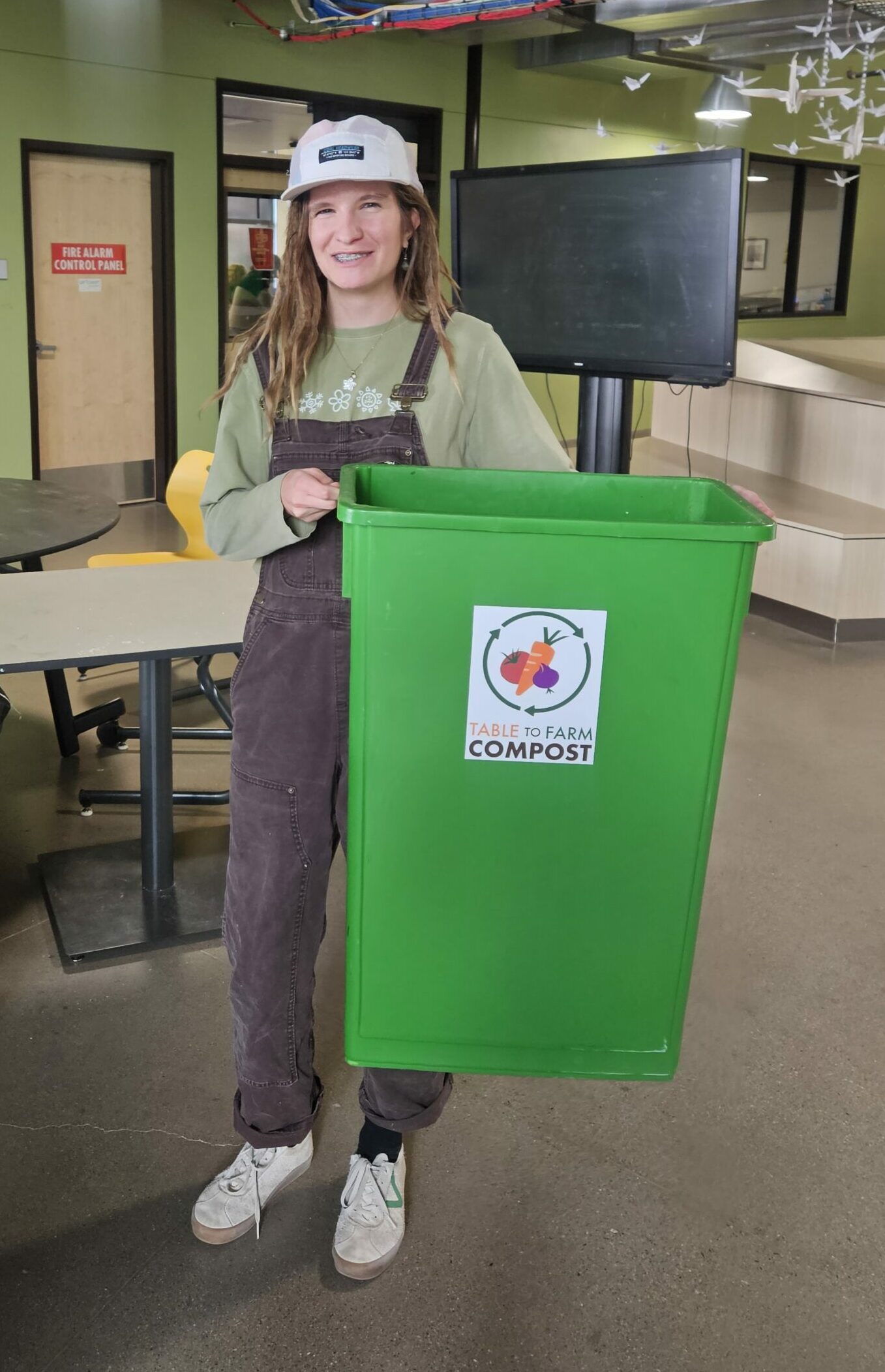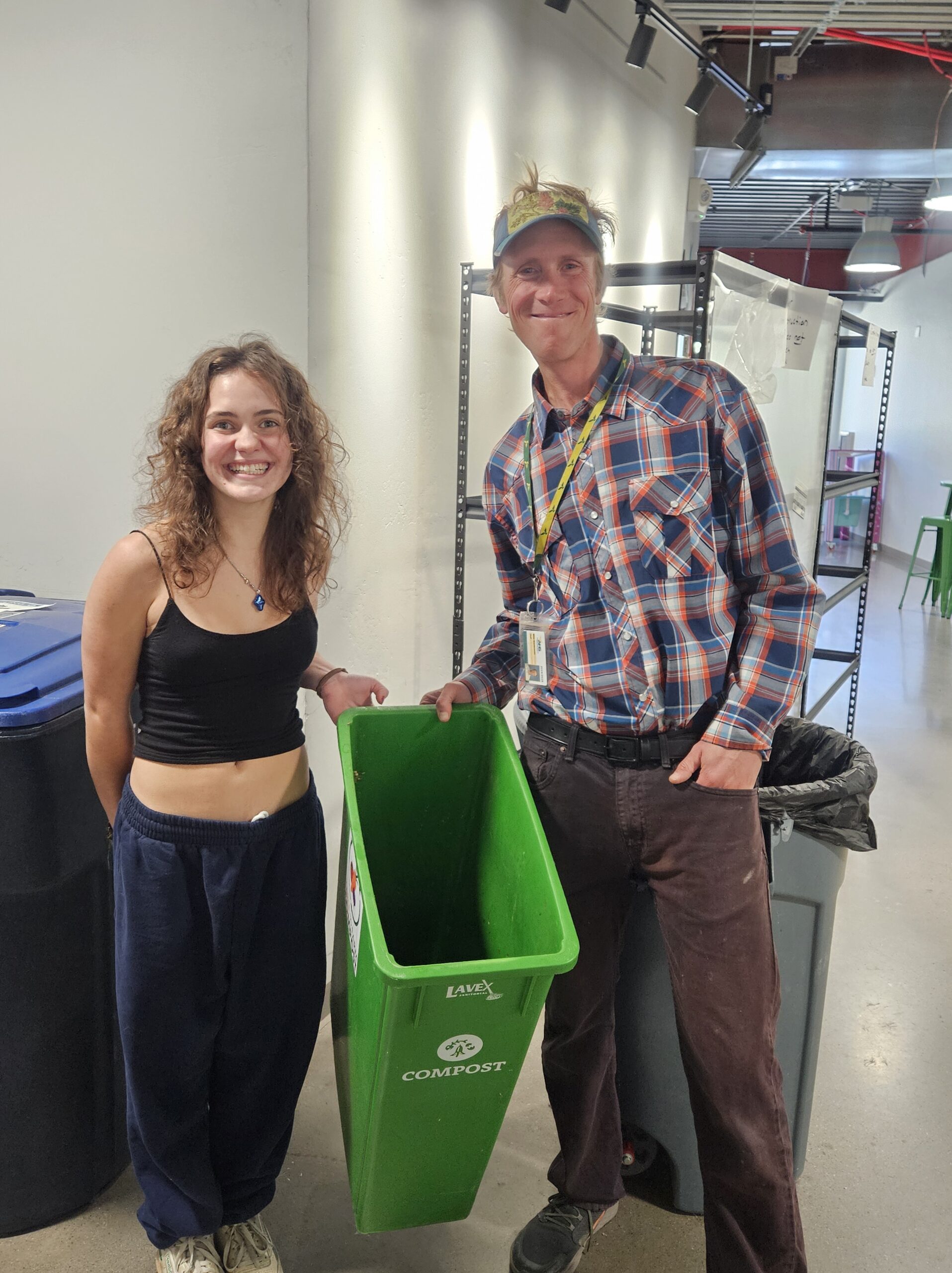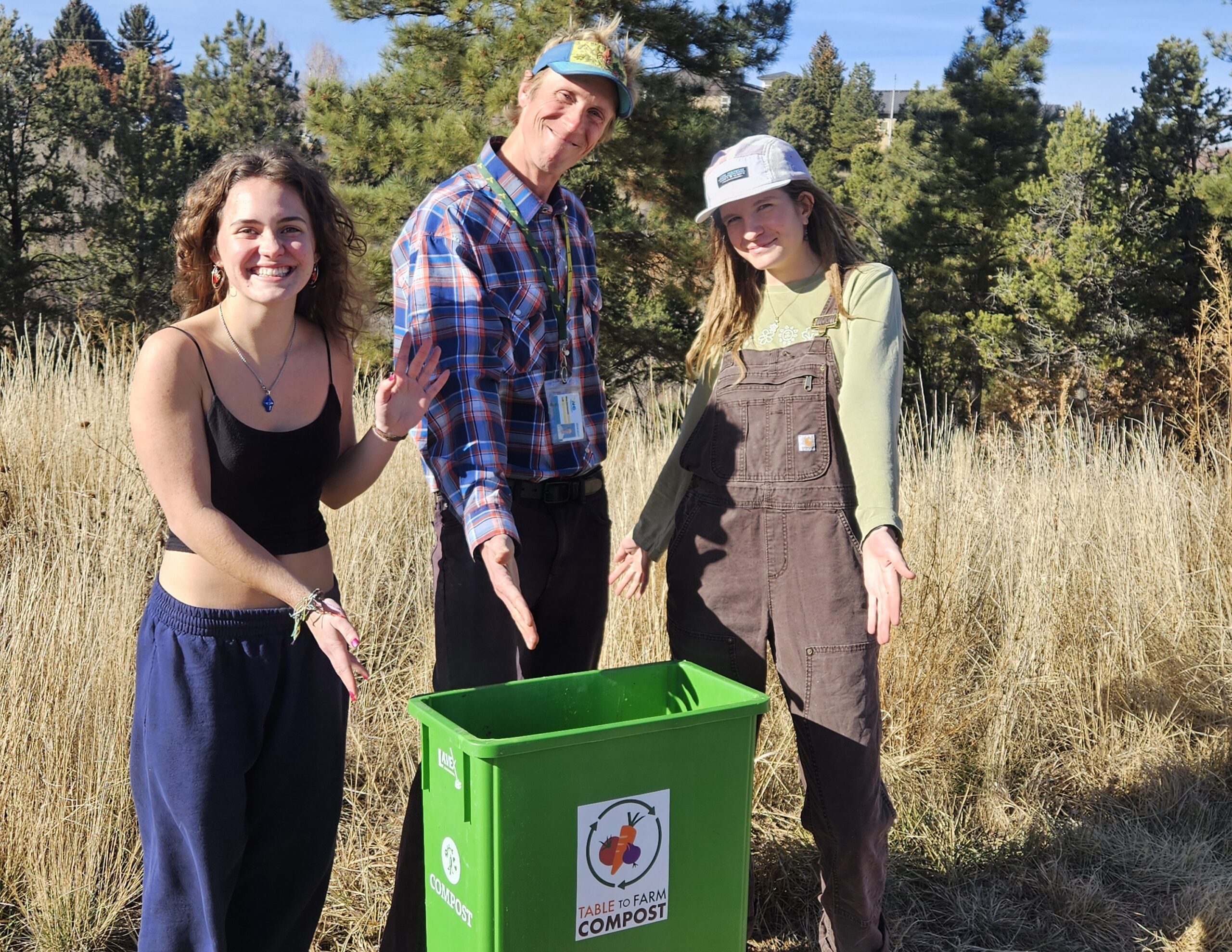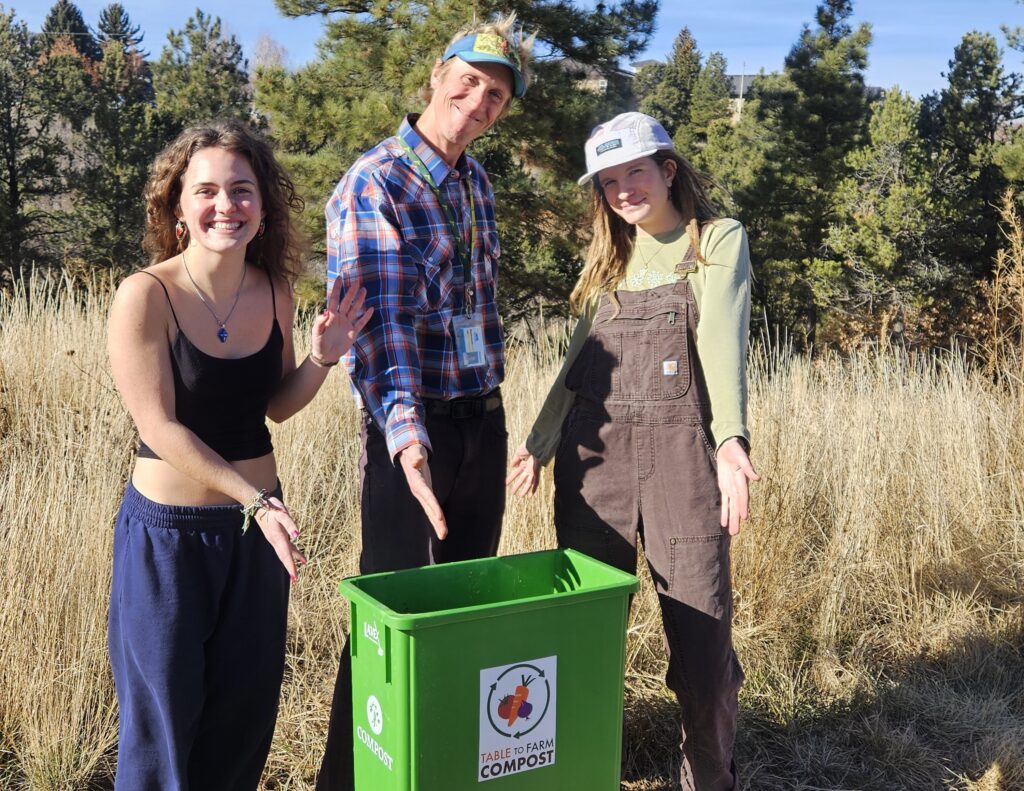Shakedowns in the AHS Cafeteria Are for Food Scraps, Not Milk Money
“Are you finished eating that?” Lacy Ruggiero holds up a green Table to Farm tote. Her classmate in the Animas High School dining area carefully considers the remnant citrus rind and uneaten crust of a sandwich. He seems unsure about surrendering them.
Lacy kindly explains how sending food scraps off to be composted prevents the scraps from rotting in a landfill where the methane byproduct will only wreak environmental havoc that ripples around the planet. Slim and lean from endurance running, and usually sporting an irresistibly friendly grin, Lacy exudes a gentle yet undeniable charisma. Her classmate readily pitches the leftovers into the bucket. Other students nearby quickly follow suit.

Every day during lunch, Lacy and a team of other volunteer students and faculty habitually cruise through the dining area armed with buckets. The school’s decision to adopt compost pickup with T2F stemmed in part from a research project Lacy spearheaded in her 9th grade biology class with veteran teacher, Mike Bienkowski.
Founded in 2009 and recently relocated into a newly constructed state-of-the-art facility, Animas High School is a tuition–free, public charter school open to all. It boasts roughly 250 high school students and 35 faculty.
Every fall, Mr. Bienkowski’s students focus on sustainability issues. Lacy was tasked with finding a sustainability issue in the local community, researching it thoroughly, and presenting her findings to her peers. Pinpointing a topic did not take long.
“Food waste is a problem in our community,” Lacy notes. However, long after her project received a passing grade, the topic still haunted her thoughts. “Okay that was a really cool project,” she recounts, going on to say, “How can I take that knowledge and apply it to my life? I compost at home but I noticed a growing amount of food in the trash [at school]. A lot of kids do eat their lunch, but they still have scraps and those scraps will build up.”
From Idea to Action
While Lacy pondered how to bridge the divide between theoretical and applied knowledge, AHS inaugurated its first student clubs. Bienkowski explains, “We started clubs this year as an interest group where students can kind of get together in a more informal setting and just enjoy something together. Faculty pitched ideas for clubs that we might like to sponsor. Similar to Lacy, I thought there are a lot of things we don’t do but should.”
Mr. Bienkowski opted to be the faculty sponsor of an Enviro Club for students dedicated to environmental issues and pursuits. Lacy did not hesitate to join. And soon after that, the club pushed to get a food waste diversion system implemented at AHS.
 Maily Lancaster, junior at AHS and member of the Enviro Club, sums up how the school now handles food waste. “What we have set up right now are compost bins around the school and we are having all students and staff members just put any of their leftovers in those bins. And then at the end of lunch, we take those bins that are in the school and we bring them out back to the big bin that is outside. [T2F] comes and takes all those scraps back to their farm.”
Maily Lancaster, junior at AHS and member of the Enviro Club, sums up how the school now handles food waste. “What we have set up right now are compost bins around the school and we are having all students and staff members just put any of their leftovers in those bins. And then at the end of lunch, we take those bins that are in the school and we bring them out back to the big bin that is outside. [T2F] comes and takes all those scraps back to their farm.”
According to Mr. Bienkowski, bringing composting into the school has been celebrated among the faculty. He notes, “Most of the teachers are like: Oh yeah! It’s good this is finally happening!” He attests that many teachers are passionate advocates for food waste diversion and do not hesitate to volunteer for monitoring the bins (to prevent contamination from trash) or consolidating bucket scraps into the outdoor tote.
Even so, the members of the Enviro Club are keenly aware that enthusiasm and action do not necessarily go hand-in-hand. In other words, just because a community is jazzed about composting does not mean it will actually adopt the new habits needed to sideline food waste from the trash bin.
Maily points out, “It needs to change and people need to be more aware about it. We learned a little about composting when I was in elementary school, but it’s not like a lot of us are gonna remember that knowledge again. So, it’s being aware and learning about it, getting it locked in people’s minds.”
To that end, the Club deploys education and outreach tactics across many fronts, besides patrolling the lunch tables. For instance, Lacy used her newfound skills acquired in her video journalism class to create an educational how-to-compost-scraps video featuring Maily and Mr. Bienkowski. The video, which was posted to the school’s Instagram feed, also highlighted why diverting food scraps from trash was important. Also, the club disseminated a survey to gather volunteers for bucket patrol. And, they place reminders to compost food in the schoolwide newsletter.
Students Become the Teachers
Two months after adopting food waste diversion, AHS students have sidelined 256 pounds of trash from the landfill. That’s equivalent to a car not driving 253 miles (spewing greenhouse gases all the way)!
The accessibility and ease of composting stands out to Lacy as key contributors to its successful implementation at the school. She points out that plenty of scientists and engineers around the world are imagining and testing high-cost, high-tech methane capture systems; whereas compost is low-cost and low-tech.
“I think anyone can do composting, whether it’s a business or a home. Even if you live in a city, there’s always some way to do composting,” she says.
For Lacy, the next initiative for the club is obvious: build a school garden! She loves the idea of food scraps gathered from the school returning as compost to feed the soil that grows the veggies and fruits that will feed her peers. When her family installed a home garden, she marveled at how its yield doubled after simply applying compost. Installing a garden creates a perfectly sustainable closed loop, or as Lacy puts it, “It would be a good classroom example of a full circle.”
When asked about a timeline for the garden, Lacy’s eyebrows tilt plaintively as she glances at Mr. Bienkowski. He laughs and tosses a casual shoulder shrug, indicating the digging and fencing could begin after the holidays. Lacy celebrates with a small fist pump.
Although they have a long way to go to reach graduation, Lacy and Maily want to keep environmental issues at the center of their future college and career paths.
Maily does not have a particular dream-school on the horizon, but she knows she wants to continue her environmental education and advocacy. “My goal and dream,” Maily says, “is to find something that is helping the environment and helping the community learn about it. I love nature. I just want to like save our environment and help our environment—give back to it because we live in a beautiful area. And just to give back to it is important.”
Lacy, however, has her sights set on attending the University of Oregon, an epicenter of environmental studies. Her dream future will ideally incorporate lots of ultra running with environmental journalism. “Not necessarily like real news,” she says, “but like bigger picture stuff, like documentaries.”
Regardless of where they wind up, students in the Enviro Club know that every action they take now plays a part in the future they will inherit. While good study habits pave the way to college or trade schools, good habits diverting food waste safeguard the wilderness wonderlands that will hopefully forever serve as their playgrounds.


